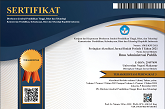Collaborative Governance of Coral Reef Management and Rehabilitation in Tsunami Disaster Mitigation Efforts
(1) Universitas Indonesia
(2) Universitas Indonesia
(*) Corresponding Author
DOI: https://doi.org/10.26858/jiap.v10i1.14055
Abstract
The tsunami is the biggest threat to countries around the world tectonic plates and the ring of fire, including Indonesia. The impact of economic losses and heavy casualties made the tsunami worth watching out. Ecosystem-based tsunami disaster mitigation efforts are deemed necessary, considering that 2/3 of Indonesia consists of the sea. The coral reef is one of the coastal ecosystems that can reduce tsunami waves by up to 50% before it hits coastal areas. However, the current condition of coral reefs is very alarming due to the actions of irresponsible humans. Collaboration between stakeholders is needed to carry out ecosystem-based tsunami disaster mitigation efforts. Collaborative governance becomes an essential issue in efforts to build and improve services in the public sector by involving all relevant stakeholders. The sectoral ego of the stakeholders is no longer relevant to be maintained because each actor has their strengths and weaknesses. Collaboration between actors framed in a collaboration platform by having a principled engagement, shared motivation, and collective capacity will produce better results.
Keywords
Full Text:
PDFReferences
Amagai, T., Ichimaru, S., Tai, M., Ejiri, Y., & Muto, A. (2014). Nutrition in the Great East Japan Earthquake Disaster. Nutrition in Clinical Practice, 29(5), 585–594. https://doi.org/10.1177/0884533614543833
Ansell, C., & Gash, A. (2008). Collaborative governance in theory and practice. Journal of Public Administration Research and Theory. https://doi.org/10.1093/jopart/mum032
Bragg, C., Gibson, G., King, H., Lefler, A. A., & Ntoubandi, F. (2018). Remittances as aid following major sudden-onset natural disasters. Disasters, 42(1), 3–18. https://doi.org/10.1111/disa.12229
Bullock, J. A., Haddow, G. D., & Coppola, D. P. (2011). Introduction to homeland security: Principles of all-hazards risk management. Butterworth-Heinemann.
Bumgarner, J. B. (2008). Emergency management: a reference handbook. ABC-CLIO.
Emerson, K., & Nabatchi, T. (2015). Collaborative governance and collaborative governance regimes. Collaborative Governance Regimes.
Emerson, K., & Nabatchi, T. (2015). Collaborative governance regimes.
Emerson, K., & Nabatchi, T. (2015). Evaluating the productivity of collaborative governance regimes: A performance matrix. Public Performance & Management Review, 38(4), 717–747.
Emerson, K., Nabatchi, T., & Balogh, S. (2012). An integrative framework for collaborative governance. Journal of Public Administration Research and Theory. https://doi.org/10.1093/jopart/mur011
Guannel, G., Arkema, K., Ruggiero, P., & Verutes, G. (2016). The power of three: coral reefs, seagrasses and mangroves protect coastal regions and increase their resilience. PloS One, 11(7).
Kunkel, C. M., Hallberg, R. W., & Oppenheimer, M. (2006). Coral reefs reduce tsunami impact in model simulations. Geophysical Research Letters, 33(23).
Neumayer, E., & Plümper, T. (2007). The Gendered Nature of Natural Disasters: The Impact of Catastrophic Events on the Gender Gap in Life Expectancy, 1981–2002. Annals of the Association of American Geographers, 97(3), 551–566. https://doi.org/10.1111/j.1467-8306.2007.00563.x
Porter, M., Skinner, T. D., & Wheelans, M. A. (1967). Structural characterization of vulcanizates. Part VIII. The N-cyclohexylbenzothiazole-2-sulfenamide-accelerated sulfur vulcanization of natural rubber at 140–180°C. and of synthetic cis-1,4-polyisoprene at 140°C. Journal of Applied Polymer Science, 11(11), 2271–2283. https://doi.org/10.1002/app.1967.070111114
Riley, J. M. (2002). Stakeholders in Rural Development: Critical Collaboration in State–NGO Partnerships. Sage Publication, 97. https://doi.org/10.1023/A:1022081926076
Rossi, P. H., Wright, J. D., Weber-Burdin, E., Pietras, M., & Diggins, W. (1982). Natural hazards and public choice. Elsevier.
Sekaran, U. (2009). Research methods for business 4th edition. Hoboken. NJ: John Wiley & Sons.
Sorooshian, S. (2005). Meeting the challenges of natural hazards in the wake of the tsunami disaster. Eos, Transactions American Geophysical Union, 86(2), 14. https://doi.org/10.1029/2005EO020005
Yamamura, E. (2013). Natural Disasters and Participation in Volunteer Activities: A Case Study of the Great Hanshin-Awaji Earthquake. Annals of Public and Cooperative Economics, 84(1), 103–117. https://doi.org/10.1111/apce.12005
Yanagisawa, H., Goto, K., Sugawara, D., Kanamaru, K., Iwamoto, N., & Takamori, Y. (2016). Tsunami earthquake can occur elsewhere along the Japan Trench—Historical and geological evidence for the 1677 earthquake and tsunami. Journal of Geophysical Research: Solid Earth, 121(5), 3504–3516. https://doi.org/10.1002/2015JB012617
Article Metrics
Abstract view : 625 times | PDF view : 136 timesRefbacks
- There are currently no refbacks.
Copyright (c) 2020 Dodi Robby Hari Ismanto, Rachma Fitriati

This work is licensed under a Creative Commons Attribution 4.0 International License.
Diterbitkan oleh:
Program Studi Ilmu Administrasi Publik
Program Pascasarjana Universitas Negeri Makassar
JIAP Index By:

This work is licensed under a Creative Commons Attribution 4.0 International License.









